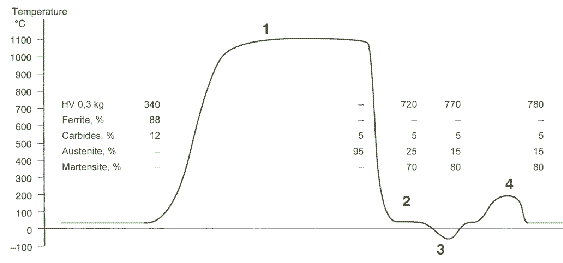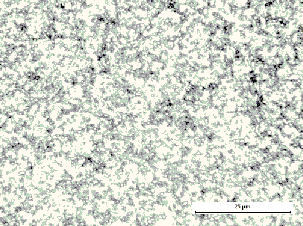Alleima® 13C26 is a martensitic stainless chromium steel characterized by:
- Excellent metallurgical properties
- Close tolerances
- Smooth surface, extra accuracy on flatness and straightness
- Good blanking properties
- Good hardening properties
- Good grinding and honing properties, facilitating the manufacture of high quality edges
- Good corrosion resistance (hardened and tempered condition)
- Consistent material properties from coil to coil, from delivery to delivery
Chemical composition (nominal)
| C | Si | Mn | P | S | Cr |
|---|---|---|---|---|---|
| 0.68 | 0.4 | 0.7 | ≤0.025 | ≤0.010 | 13 |
Forms of supply
Razor blade steel, Alleima® 13C26, is supplied as cold rolled strip in coils. The tensile strength is 1070±100 MPa (155±14.5 ksi). The strip is supplied with a dull, very fine surface, slit edges and extra accuracy on straightness. Wide strip is slit into finished sizes in special slitters with cemented carbide tools, which give very high edge quality and very close width tolerances. A corrosion-preventive oil is applied to the strip. Coils are carefully packed, with various packing materials being used according to customer requirements, destination and method of transport.
Coil sizes
Razor blade strip is wound into pancake coils on plastic cores with an inner diameter of 280 mm (11,0 in.). The coils can be supplied in weights between 1 and 5 kg/mm strip width, which means an outer diameter from about 500 to 1000 mm (20-40 in.)
| Strip thickness | Thickness tolerance | ||
|---|---|---|---|
| mm | in. | mm ± | in. ± |
| 0.076 | 0.0030 | 0.005 | 0.00020 |
| 0.099 | 0.0039 | 0.005 | 0.00020 |
Width
Widths range between 5 and 26 mm (0,2-1,0 in.).
Other dimensions and forms of supply can be supplied to meet specific requirements.
Heat treatment
The recommended heat treatment for Alleima® 13C26 follows the temperature cycle illustrated in figure 3.
During heating [1], or austenitizing, the ferrite is transformed into austenite and the carbides are partly dissolved. Because of the carbide dissolution, the contents of carbon and chromium in the matrix increase. The subsequent quenching to room temperature [2] will transform most of the austenite into martensite. During deep freezing of the material to -70°C (-94°F) [3], even more austenite is transformed into martensite. The remainder, about 15 %, is known as retained austenite. Finally, since the material is now very brittle, the toughness, and also the hardness, is increased by a tempering treatment [4].
 Figure 3. Temperature cycle for hardening of Alleima® 13C26. [1] 25 seconds above 1000°C (1830°F); 10 seconds at top temperature 1080-1100°C (1975-2010°F). All values are approximate and only for guidance.
Figure 3. Temperature cycle for hardening of Alleima® 13C26. [1] 25 seconds above 1000°C (1830°F); 10 seconds at top temperature 1080-1100°C (1975-2010°F). All values are approximate and only for guidance.
Properties after hardening
Hardness
The martensite content and the amount of retained austenite mainly determine the hardness in the hardened and tempered condition. Martensite becomes harder with increasing carbon content. The higher the austenitizing temperature, the higher the content of carbon in the subsequently formed martensite.
On the other hand, the more carbon in the matrix at austenitizing, the more austenite will be retained after quenching and deep freezing. Since austenite is softer than martensite, this will reduce the hardness.
These two contradictory effects indicate that for Alleima® 13C26, there is an optimum combination of hardening temperature and time.
Corrosion resistance
Due to the dissolution of carbides during heat treatment, the chromium content of the matrix increases. Good corrosion resistance is achieved with a chromium content of 11-12 %. This is obtained by a heat treatment that leaves about 15 % of retained austenite after quenching and deep freezing, see figure 3.
Physical properties
The physical properties of a steel are related to a number of factors, including alloying elements, heat treatment and manufacturing route, but the data presented below can generally be used for rough calculations.
| Density | |
|---|---|
| g/cm3 | 7.7 |
| lb/in.3 | 0.28 |
Microstructure
Unhardened condition ('as delivered')
In the 'as delivered', unhardened condition, Alleima® 13C26 consists of finely dispersed carbides in a ferritic matrix, see figure 1. The carbides are of type M23C6, where M stands for iron and chromium. This type of carbide is easily dissolved during the heat treatment, which is important for good hardening results. The fine dispersion of the carbides also helps to speed up their dissolution, allowing lower furnace temperatures and higher speeds during hardening.
The ferritic matrix has low contents of carbon and chromium because these elements are bound in carbides. Since the chromium content in the matrix determines the corrosion resistance of the steel, the material has limited resistance to corrosion in the 'as delivered' condition.
Because of very careful control in the manufacture of the steel, large carbides - known as primary carbides - can be avoided, and the amount of non-metallic inclusions can be kept to a minimum. This contributes significantly to the quality of the razor blade edge. Careful process control also ensures that the chemical composition can be kept within very close limits, which results in consistent steel properties.

Figure 1. Alleima® 13C26 'as delivered', unhardened.
Hardened and tempered condition
After hardening and tempering, Alleima® 13C26 consists of a martensitic matrix with undissolved carbides and some retained austenite, as shown in figure 2. In this condition the steel has good corrosion resistance.

Figure 2. Alleima® 13C26 hardened and tempered.
Disclaimer: Recommendations are for guidance only, and the suitability of a material for a specific application can be confirmed only when we know the actual service conditions. Continuous development may necessitate changes in technical data without notice. This datasheet is only valid for Alleima materials.